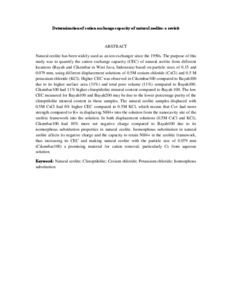Citation
Abdul Sukor, Arina Shairah and A. Z. A., Azira and Mohd Hanif, Ahmad Husni
(2017)
Determination of cation exchange capacity of natural zeolite: a revisit.
Malaysian Journal of Soil Science, 21.
pp. 105-112.
ISSN 1394-7990
Abstract
Natural zeolite has been widely used as an ion exchanger since the 1950s. The purpose of this study was to quantify the cation exchange capacity (CEC) of natural zeolite from different locations (Bayah and Cikembar in West Java, Indonesia) based on particle sizes of 0.15 and 0.079 mm, using different displacement solutions of 0.5M cesium chloride (CsCl) and 0.5 M potassium chloride (KCl). Higher CEC was observed in Cikembar100 compared to Bayah100 due to its higher surface area (31%) and total pore volume (11%) compared to Bayah100. Cikembar100 had 11% higher clinoptilolite mineral content compared to Bayah 100. The low CEC measured for Bayah100 and Bayah200 may be due to the lower percentage purity of the clinoptilolite mineral content in those samples. The natural zeolite samples displaced with 0.5M CsCl had 6% higher CEC compared to 0.5M KCl, which means that Cs+ had more strength compared to K+ in displacing NH4+ into the solution from the nanocavity site of the zeolitic framework into the solution. In both displacement solutions (0.5M CsCl and KCl), Cikembar100 had 10% more net negative charge compared to Bayah100 due to its isomorphous substitution properties in natural zeolite. Isomorphous substitution in natural zeolite affects its negative charge and the capacity to retain NH4+ in the zeolitic framework, thus increasing its CEC and making natural zeolite with the particle size of 0.079 mm (Cikembar100) a promising material for cation removal, particularly Cs from aqueous solution.
Download File
![[img]](http://psasir.upm.edu.my/14183/1.hassmallThumbnailVersion/Determination%20of%20cation%20exchange%20capacity%20of%20natural%20zeolite%20a%20revisit.pdf)  Preview |
|
Text (Abstract)
Determination of cation exchange capacity of natural zeolite a revisit.pdf
Download (37kB)
| Preview
|
|
Additional Metadata
Actions (login required)
 |
View Item |

